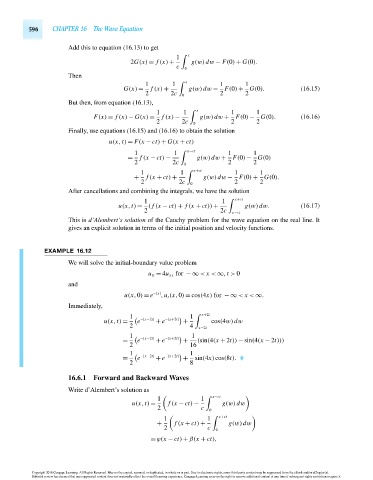Page 616 - Advanced_Engineering_Mathematics o'neil
P. 616
596 CHAPTER 16 The Wave Equation
Add this to equation (16.13) to get
1 x
2G(x) = f (x) + g(w)dw − F(0) + G(0).
c 0
Then
1 1 x 1 1
G(x) = f (x) + g(w)dw − F(0) + G(0). (16.15)
2 2c 0 2 2
But then, from equation (16.13),
1 1 x 1 1
F(x) = f (x) − G(x) = f (x) − g(w)dw + F(0) − G(0). (16.16)
2 2c 0 2 2
Finally, use equations (16.15) and (16.16) to obtain the solution
u(x,t) = F(x − ct) + G(x + ct)
1 1 x−ct 1 1
= f (x − ct) − g(w)dw + F(0) − G(0)
2 2c 0 2 2
1 1 x+ct 1 1
+ f (x + ct) + g(w)dw − F(0) + G(0).
2 2c 0 2 2
After cancellations and combining the integrals, we have the solution
1 1 x+ct
u(x,t) = ( f (x − ct) + f (x + ct)) + g(w)dw. (16.17)
2 2c x−ct
This is d’Alembert’s solution of the Cauchy problem for the wave equation on the real line. It
gives an explicit solution in terms of the initial position and velocity functions.
EXAMPLE 16.12
We will solve the initial-boundary value problem
u tt = 4u xx for −∞ < x < ∞,t > 0
and
u(x,0) = e −|x| ,u t (x,0) = cos(4x) for −∞ < x < ∞.
Immediately,
1 x+2t
1
u(x,t) = e −|x−2t| + e −|x+2t| + cos(4w)dw
2 4 x−2t
1
1
= e −|x−2t| + e −|x+2t| + (sin(4(x + 2t)) − sin(4(x − 2t)))
2 16
1
1
= e −|x−2t| + e −|x+2t| + sin(4x)cos(8t).
2 8
16.6.1 Forward and Backward Waves
Write d’Alembert’s solution as
1 1 x−ct
u(x,t) = f (x − ct) − g(w)dw
2 c 0
1 1 x+ct
+ f (x + ct) + g(w)dw
2 c 0
=ϕ(x − ct) + β(x + ct),
Copyright 2010 Cengage Learning. All Rights Reserved. May not be copied, scanned, or duplicated, in whole or in part. Due to electronic rights, some third party content may be suppressed from the eBook and/or eChapter(s).
Editorial review has deemed that any suppressed content does not materially affect the overall learning experience. Cengage Learning reserves the right to remove additional content at any time if subsequent rights restrictions require it.
October 14, 2010 15:23 THM/NEIL Page-596 27410_16_ch16_p563-610

